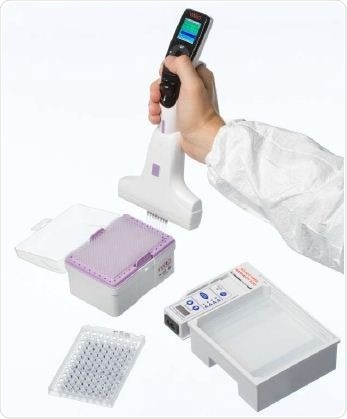Over the last decades, multichannel pipettes have become a ubiquitous liquid handling tool for molecular biology and biochemical assays in life science laboratories. This demand for multichannel pipettes is driven by the need to improve productivity owing to several reasons, including faster sample processing and analysis, increasing sample numbers, and running the business in the most profitable manner as desired by shareholders.
Despite this fact, standard applications in many laboratories involve moving the samples between various labware formats because the samples are usually prepared or collected in vessels which are different from other vessels in which subsequent working process steps are performed. In many labs, it is a routine task to move the samples from racked single tubes to 384- or 96-well assay plates; 6-, 24- or 48-well cell culture plates, SDS or agarose gels, and PCR plates or strips.

However, the productivity of a lab may dip due to many of these reformatting steps. Conventionally, the liquid handling steps are executed with a single channel pipette which can be a time-consuming process if the number of samples is more. Buying an automated liquid handler to expedite this process may prove to be an expensive option for many labs and can also introduce new complexities to an otherwise simple task.
The Solution
The need for a simple and fast sample reformatting is now addressed by the availability of a new generation of adjustable spacing pipettes. In addition to providing all the features of a typical electronic multichannel pipette, the advanced liquid handling tools enable the user to program a required spacing between tubes, wells, or gel pockets. During pipetting, users can simply press a button to automatically change the spacing between the pipette tips. This allows the samples to be transferred between different labware, just as well as between labware of the same format.
Adjustable Tip Spacing – In Action
The loading of an agarose gel from a PCR plate is an application that shows the benefits of adjustable tip spacing. By using an adjustable spacing pipette, users can load the pipette tips from the tip rack, push a button to bring them to 9.0 mm spacing for the PCR plate, aspirate the required sample volume, re-press the button to adjust tip spacing, for instance, to 4.5mm of sample wells spacing of the agarose gel, and dispense the samples inside the wells.
In approximately 17 seconds, 2μL of sample is added to eight wells of an agarose gel using an eight-channel 12.5μL Voyager Multichannel Pipettor. This time duration includes loading the tips, aspirating the sample, dispensing to the gel box, and ejecting the tips. If a single channel pipette is used, the same process can take more than a minute to complete.
Another application in which an adjustable spacing pipette can be very useful is the reformatting between two different assay or cell culture well plates. For instance, when setting up cell-based assays, the actual assay is conducted in a 96-well plate although the individual cell lines are usually grown in the larger volume 48- and 24-well cell culture plates.
The tip spacing can be adjusted from 9.00mm to 19.50mm using a six-channel Voyager Multichannel Pipettor. Thus, labs performing cell-based assays can load the pipette tips at the 9.00mm-spacing of the 96-well format, and by simply pressing a button, can expand the tip spacing to the a 48-well format (13.08mm) or the 24-well format (19.30mm). Once the cells have been aspirated, the tip spacing can be adjusted to the 96-well format (9.00 mm) by simply pressing the button. It takes around 90 seconds for a 48-well plate with the 6-channel Voyager Multichannel pipette, whereas with a single channel pipette, the time taken is approximately 8 minutes for the same process.
There is a substantial improvement in the reliability, safety, and comfort of setting up the experiment, because the failure rate of pipetting and the number of pipetting steps is lowered by a factor of 6 when using the six-channel Voyager Multichannel Pipettor.
Conclusion
Documentation on the productivity benefits of single channel versus multichannel pipetting is available.
The adjustable spacing multichannel pipetting is available in the INTEGRA VIAFLO VOYAGER. Thanks to this, laboratories have a new valuable tool for speeding up tasks in which samples require reformatting as well as increasing precision, comfort, and reliability of the pipetting procedure. The Voyager Multichannel Pipette is an ideal liquid handling tool, and closes the gap between time-intensive single channel transfers and buying an expensive automated multichannel liquid handling system.
About INTEGRA
 INTEGRA provides innovative solutions for Liquid Handling and Media Preparation applications which serve the needs of their customers in research, diagnostics and quality control laboratories.
INTEGRA provides innovative solutions for Liquid Handling and Media Preparation applications which serve the needs of their customers in research, diagnostics and quality control laboratories.
Their instruments and plastic consumables are developed and manufactured in Zizers, Switzerland and Hudson, NH USA. In order to remain close to their customers, they maintain a direct sales and support organization in North America, the UK, France and Germany, as well as a network of over 100 highly trained distribution partners worldwide.
In recent years they have focused on developing a new and technologically advanced range of handheld electronic pipettes which are simple to use and meet the ergonomic needs of their customers.
Today they are proud to offer the widest range of electronic pipettes in the market spanning a range from single channel pipettes up to 384 channel bench-top instruments.
Sponsored Content Policy: News-Medical.net publishes articles and related content that may be derived from sources where we have existing commercial relationships, provided such content adds value to the core editorial ethos of News-Medical.Net which is to educate and iform site visitors interested in medical research, science, medical devices and treatments.